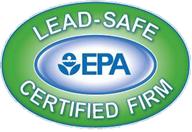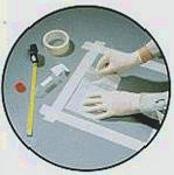The EPA has issued a FAQ document to help clarify their intent regarding the June 18, 2010 memo that delayed enforcement of the Certification requirements. The text of the clarification document is as follows:
Frequent Questions on EPA's June 18, 2010 Implementation Guidance for the Renovation, Repair and Painting Rule
Q. Does EPA's announcement of June 18, 2010, modify the Lead Renovation Repair and Painting Rule's requirements that contractors use lead-safe work practices when working in pre-1978 housing or child-occupied facilities?

No. This announcement does not change the requirement that all contractors take steps to protect children and families from the dangers of lead poisoning by becoming certified and following the work practice standards and the associated recordkeeping requirements. As of April 22, all contractors have been required to be certified and follow the work practice standards described on EPA's website. The effect of the June 18 memorandum only provides firms more time to apply for and obtain certification as a lead-based paint renovation firm before active enforcement of the firm certification requirements begins. EPA is also providing individual workers additional time to enroll in and take the required training course to become certified lead-based paint renovators before active enforcement of the individual renovator training requirements begins. EPA will use its enforcement authority to ensure compliance by enforcing work practice standards and their associated recordkeeping requirements against all renovators and firms. Therefore, renovators who have not been able to complete the training requirements are advised to review EPA's model training materials available at www.epa.gov/lead/pubs/training.htm. Additional information on lead-safe work practices can be found at www.epa.gov/lead or obtained from the National Lead Information Center at 1-800-424-LEAD (5323).

All renovation firms, even those not yet certified under the RRP rule, are also reminded of their continuing obligations to comply with Lead Renovation, Repair and Painting Rule's pre-renovation information distribution requirements, which require that before firms begin each renovation on pre-1978 housing or child-occupied facilities and to comply with the associated recordkeeping requirements. These requirements are explained in EPA's Small Entity Compliance Guide to Renovate Right.
Q. Does the June 18, 2010, announcement mean that EPA will not enforce certification and training requirements until after October 1, 2010, for firms and December 31, 2010, for renovators?
A. EPA is not stopping its enforcement against any renovation firms and individual renovators who do not comply with requirements of work practice standards and associated recordkeeping requirements. However, EPA is providing additional time for renovation firms and workers to obtain the necessary training and certifications before enforcement of the firm certification and individual renovator requirements begins.
Renovation Firms. Until October 1, 2010, EPA will not take enforcement action for violations of the RRP rule's firm certification requirement.
Individual Renovators. EPA will not enforce against individual renovation workers for failure to be trained if the person has applied to enroll in, or has enrolled in, by not later than September 30, 2010, a certified renovator class to train contractors in practices necessary for compliance with the final rules. Individual renovators must complete the training by December 31, 2010. Renovators who have not been able to complete the training requirements are advised to review EPA's model training materials available at www.epa.gov/lead/pubs/training.htm. Additional information on lead-safe work practices can be found at www.epa.gov/lead or obtained from the National Lead Information Center at 1-800-424-LEAD (5323).
Q. Thousands of renovators are already trained and their firms are EPA certified. Will EPA enforce against renovators who did not receive their training certification before December 31, 2010?
A. It is most important that all contractors follow the RRP work practice standards. However, EPA is providing additional time for renovation firms and workers to obtain the necessary training and certifications before the enforcement of the firm certification and individual renovator requirements begins. Therefore, renovators who have not been able to complete the training requirements are advised to review EPA's model training materials available at www.epa.gov/lead/pubs/training.htm. Additional information on lead-safe work practices can be found at www.epa.gov/lead or obtained from the National Lead Information Center at 1-800-424-LEAD (5323).
Q. Doesn't the June 18 memorandum extend an unfair advantage to members of the regulated community who have delayed compliance with the certification and training requirements and punish those who have complied with the rule?
 A. EPA does not believe that allowing more time for firms to become certified and renovators to become trained extends an unfair advantage. To the contrary, firms that are already certified can benefit by continuing to advertise that they are certified and may continue to use EPA's program logo during this interim period. The Agency also recognizes the challenges some are facing in obtaining training in a timely fashion and is providing additional time to individual renovators to enroll in and take the required training courses before the Agency actively enforces the individual renovator requirements. EPA is committed to encouraging additional training opportunities in every state to meet this demand for classes.
A. EPA does not believe that allowing more time for firms to become certified and renovators to become trained extends an unfair advantage. To the contrary, firms that are already certified can benefit by continuing to advertise that they are certified and may continue to use EPA's program logo during this interim period. The Agency also recognizes the challenges some are facing in obtaining training in a timely fashion and is providing additional time to individual renovators to enroll in and take the required training courses before the Agency actively enforces the individual renovator requirements. EPA is committed to encouraging additional training opportunities in every state to meet this demand for classes.
Q. How does the June 18 announcement impact renovators in states that have adopted their own RRP programs?
A. As of June 21, 2010, eight states -- Wisconsin, Iowa, North Carolina, Mississippi, Kansas, Rhode Island, Utah, and Oregon - administer and enforce their own RRP programs.
Renovators working in these states must comply with all applicable state laws, notwithstanding this guidance.
Q. What happens if an individual applied or was accepted for training before October 1, 2010, but the course is cancelled or delayed by the training provider during that 90-day period (October 1 - December 31, 2010)? What recourse does the individual renovation worker have after 12/31/10?
A. The renovator must complete training by December 31, 2010. EPA encourages renovators and firms to take advantage of this opportunity and not delay in becoming trained and certified.
Q. How soon should renovation firms send their applications to EPA?
A. Firms should send their applications to EPA as soon as possible. All firms that are not certified by October 1, 2010, will be subject to penalties for failing to comply with the renovation firm requirements of the RRP rule. EPA has been working to expedite processing of applications but, under the regulations, may take up to 90 days.

 Looking for accurate information about the EPA RRP rule?
Looking for accurate information about the EPA RRP rule? 



 Senate moves to put off EPA RRP lead-paint violation fines
Senate moves to put off EPA RRP lead-paint violation fines  Sponsored by Sen. Susan Collins, R-Maine, the proposal was attached to a supplemental funding bill by a vote of 60-37.
Sponsored by Sen. Susan Collins, R-Maine, the proposal was attached to a supplemental funding bill by a vote of 60-37.  For months, Sen. Jim Inhofe, R-Okla., has helped lead efforts on the EPA's implementation of the rule, which has sparked both concern and controversy in Oklahoma.
For months, Sen. Jim Inhofe, R-Okla., has helped lead efforts on the EPA's implementation of the rule, which has sparked both concern and controversy in Oklahoma.  Sen. Barbara Boxer, D-Calif., the chairwoman of the committee, argued against the Collins amendment. She spoke of the dangers of lead poisoning, especially to children, infants and pregnant women, and urged her fellow senators to reject Collins' effort to block enforcement of the rule.
Sen. Barbara Boxer, D-Calif., the chairwoman of the committee, argued against the Collins amendment. She spoke of the dangers of lead poisoning, especially to children, infants and pregnant women, and urged her fellow senators to reject Collins' effort to block enforcement of the rule.  Here is the latest listing of EPA RRP Certified Firms as of May 19th, 2010
Here is the latest listing of EPA RRP Certified Firms as of May 19th, 2010 
 On April 22, 2010. the EPA added an
On April 22, 2010. the EPA added an  "This final rule requires that, if dust clearance is performed in lieu of cleaning verification, the renovation firm provide a copy of the dust wipe sampling report(s) to the owner of the building that was renovated as well as to the occupants, if different. With respect to renovations in common areas of target housing or in child-occupied facilities, EPA is also requiring that these records be made available to the tenants of the affected housing units or the parents and guardians of children under age 6 using the child-occupied facilities. Dust sampling reports may be made available to these groups in the same way as training and work practice records, by providing information on how to review or obtain copies in individual notifications or on posted signs."
"This final rule requires that, if dust clearance is performed in lieu of cleaning verification, the renovation firm provide a copy of the dust wipe sampling report(s) to the owner of the building that was renovated as well as to the occupants, if different. With respect to renovations in common areas of target housing or in child-occupied facilities, EPA is also requiring that these records be made available to the tenants of the affected housing units or the parents and guardians of children under age 6 using the child-occupied facilities. Dust sampling reports may be made available to these groups in the same way as training and work practice records, by providing information on how to review or obtain copies in individual notifications or on posted signs."


